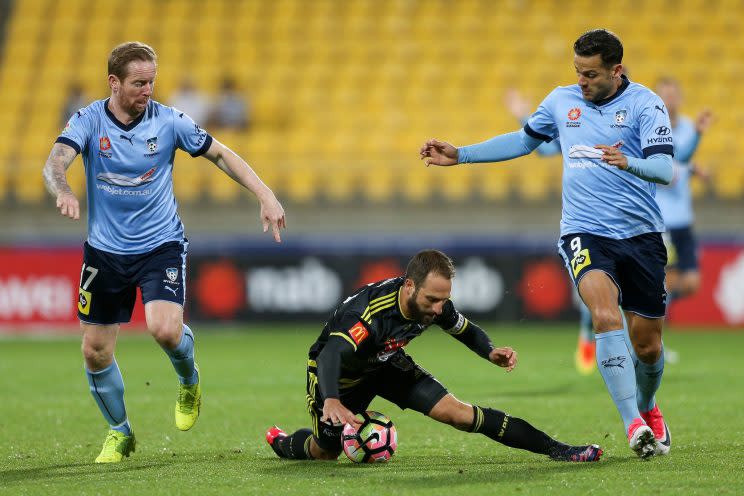Video replays make club debut as Sydney benefit in Wellington clash

Watch out, world football. A storm is coming.
After years of lobbying to get referees additional help – no, Mr Platini, having a 15th official won’t make a difference – video replay technology has arrived in club football with a baptism of fire.
And what better a dramatic scene setter than New Zealand?
For those who missed Saturday morning’s triumph for officiating, here’s the lowdown.
READ MORE: Premier League’s most improved players this season club-by-club
READ MORE: The best 15 players EVER to have been relegated from the Premier League
A League premiers (or, to folk accustomed to the other term, champions) Sydney FC had a corner. The ball is whipped in towards defender Alex Wilkinson, and cleared away by Marco Rossi.
All good, right? Wrong. Four Sydney players surround the referee in a gigantic appeal – at least some things never change.
Phoenix counter attack, Guilherme Finkler slides in Roy Krishna who – albeit called offside – fires wide.
The referee – still under an element of duress from the Sky Blues players – then consults with his video referee, and what do you know? Rossi punched the ball clear. Under pressure from Wilkinson, it must be added.
So where do we start? Ultimately, the decision was correct, the referee made the correct call in the end and Wellington salvaged a draw in stoppage time.
Win, win, right? Regardless of if you are a fan of video replays or not, there was a triumphant – and surreal – atmosphere as the question of “what if?” no longer became relevant.
But in this particular instance – the first in club football – the application raised some potential pitfalls.
Consider the time between the incident and the referee going upstairs. Approximately 35 seconds. And as we all know, plenty can happen in half a minute of football.
Phoenix, for example, might have stuck the ball legitimately in the net? And then what – does the referee have the bottle to defer the goal, and go back to the penalty incident? Only time – and experience – will provide us with an answer.
Next, the actual decision to go upstairs. The referee on this occasion, Shaun Evans, seemed to be under considerable influence.
If he wanted another look at the incident, given what appeared to be a genuine appeal for the handball in the first instance, and was just waiting until open play, then obviously that is his prerogative.
But there is a real risk of undue player influence turning the VAR (video assistant referee) system into a football-equivalent of the Decision Review System (DRS) in cricket.
Finally, the actual VAR decision, on this occasion made by official Jarred Gillett.
The decision took 20 seconds to make. That’s two slow-motion replays of the corner kick, at two different angles. No problem there.
But the incident only seemed to be looked at in isolation. Now, unlike the cricket DRS system, we don’t know what the officials were discussing, or what they were thinking about.
READ MORE: Saturday’s top football transfer rumours including James Rodriguez and David Ospina
But there is a genuine case to be made for Rossi; after all, his arms could well have been a result of Wilkinson climbing all over him.
Attacking players using a defender as leverage is nothing new in football, and the referee may well have adjudged there to be minimal contact.
Fair enough, but we don’t know for sure that that was considered. And that could be a considerable omission on the referees behalf.
One thing is for sure – today was a triumph for football. The technology worked, it worked quickly, and the correct decision was made.
But the process will need refining on this morning’s evidence, and there are bound to be more case studies in the coming weeks.

 Yahoo Sport
Yahoo Sport 






































